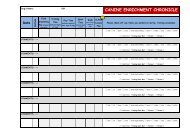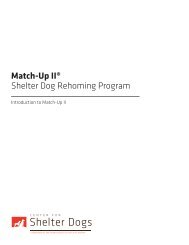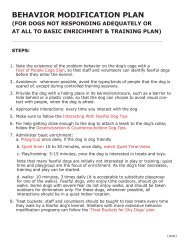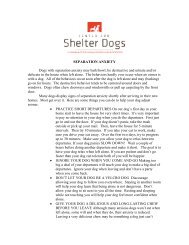Match-Up II Manual - Center for Shelter Dogs
Match-Up II Manual - Center for Shelter Dogs
Match-Up II Manual - Center for Shelter Dogs
Create successful ePaper yourself
Turn your PDF publications into a flip-book with our unique Google optimized e-Paper software.
<strong>Match</strong>-<strong>Up</strong> <strong>II</strong><br />
Behavioral Triage<br />
Calculating Triage Points<br />
When using <strong>Match</strong>-<strong>Up</strong> <strong>II</strong> Online, triage points will be automatically<br />
calculated <strong>for</strong> you. If you are using the paper-based version<br />
of <strong>Match</strong>-<strong>Up</strong> <strong>II</strong>, you will need to refer to the Behavioral Triage<br />
Worksheet (Appendix C). You will need in<strong>for</strong>mation from the dog’s<br />
intake profile (behavioral history), behavior evaluation results and<br />
behavior observed in the shelter to calculate triage points.<br />
Within each of the three parts of the <strong>Match</strong>-<strong>Up</strong> <strong>II</strong> Behavioral<br />
Triage section: (behavioral history, behavior evaluation, behavior<br />
in the shelter) there are sub-sections which ask about behaviors<br />
of different types (<strong>for</strong> example, aggression toward people versus<br />
toward other dogs versus fear). For each sub-section, check the<br />
box <strong>for</strong> all behaviors that apply and follow the scoring instructions<br />
on the behavioral triage worksheet. For the behavioral hstory<br />
section (section 1), you will need to refer to the dog's intake<br />
<strong>for</strong>m,<strong>for</strong> the behavior evaluation (section 2) you will need to refer<br />
to the in<strong>for</strong>mation in on the behavior evaluation worksheet, and<br />
<strong>for</strong> the behavior observed in the shelter (section 3) you will need<br />
to refer to your own internal records or shelter staff records such<br />
as dog records, log sheets or in<strong>for</strong>mation from your shelter's<br />
software program.<br />
Please read the instructions contained within each section of<br />
the behavioral triage worksheet when completing it in order to<br />
enter the points correctly. In most places, you will enter ONLY the<br />
highest single point value <strong>for</strong> a “behavior type” (aggression, fear,<br />
etc.) in that sub-section into the section total. For example, if a<br />
dog has growled and snapped at adults, you would check both +6<br />
<strong>for</strong> growl at adults and +8 <strong>for</strong> snap at adults, but you would only<br />
add +8 to the behavioral history section subtotal. However, review<br />
the triage scoring instructions carefully <strong>for</strong> each section because<br />
some places will ask you to add certain scores together versus<br />
choosing the highest point value score.<br />
In order to account <strong>for</strong> the effect of increased size and strength<br />
when a big dog exhibits aggressive or arousal behaviors,<br />
additional points may be added <strong>for</strong> weight. Weight points<br />
are ONLY added or subtracted if the dog receives points <strong>for</strong><br />
aggressiveness or excitability behaviors. <strong>Dogs</strong> without any points<br />
or with points only from a missing intake or fear behaviors should<br />
not have weight points added or subtracted to their score.<br />
Add the number of points from each sub-section and enter at the<br />
bottom of each section (behavioral history, behavior evaluation,<br />
behavior observed in shelter, and weight). Total the number of<br />
points from each section and record in the ‘TOTAL TRIAGE POINTS’<br />
box on page 1 and 8. Enter the total triage points at the top of the<br />
Behavioral Triage worksheet.<br />
Determining Outcome Categories<br />
The behavioral triage points are used to help make<br />
recommendations <strong>for</strong> placement and rehoming. A decision on a<br />
dog's triage outcome category should be guided by the shelter, its<br />
resources, and its position to manage specific problem behaviors.<br />
Triage Point Range Descriptions<br />
0-3 Points<br />
The dog exhibited few or no problematic behaviors and is likely to be<br />
a good candidate <strong>for</strong> adoption with routine screening and counseling.<br />
4- 20 points<br />
The dog exhibited some problematic behaviors and is likely to be a<br />
candidate <strong>for</strong> adoption into a selected home. The dog may benefit<br />
from behavior modification training in the shelter and/or problembased<br />
behavior counseling.<br />
21+ Points<br />
The dog exhibited numerous and/or severe problematic behaviors<br />
and should be evaluated carefully in terms of adoption prospects in<br />
the community. If it is decided to place dog the dog is likely to benefit<br />
from behavior modification training in the shelter and/or problembased<br />
behavior counseling.<br />
Triage Outcome Categories<br />
0 – 3 Points, No Aggression Noted:<br />
• Suitable <strong>for</strong> adoption with routine screening and counseling<br />
4+ Plus Points or 0 - 3 Points with Aggression Noted:<br />
• Suitable <strong>for</strong> adoption with routine screening and counseling, may<br />
have some restrictions.<br />
• Suitable <strong>for</strong> adoption with problem-based behavior counseling<br />
required.<br />
• Suitable <strong>for</strong> adoption with both behavior modification training and<br />
problem-based behavior counseling required.<br />
• Suitable <strong>for</strong> adoption with behavior modification training,<br />
problem-based behavior counseling, and post-adoption<br />
counseling required.<br />
• Suitable <strong>for</strong> interim placement into a foster home or training facility<br />
<strong>for</strong> behavior modification, followed by re-evaluation.<br />
• Not suitable <strong>for</strong> adoption into a community (household) setting.<br />
Note: It is recommended that if any new behaviors of concern occur<br />
in a shelter such as fear, aggression or excitability, the dog's triage<br />
points should be recalculated.<br />
12










